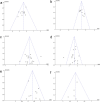A systematic review and meta-analysis on effects of aerobic exercise in people with Parkinson's disease
- PMID: 36316416
- PMCID: PMC9622812
- DOI: 10.1038/s41531-022-00418-4
A systematic review and meta-analysis on effects of aerobic exercise in people with Parkinson's disease
Abstract
Previous studies have shown that aerobic exercise is an effective way to improve symptoms of Parkinson's disease (PD). The aim of this study [PROSPERO CRD42022340730] was to explore the effects of aerobic exercises on balance, gait, motor function, and quality of life in PD patients. Searches were performed in PubMed, Web of Science, and EBSCO electronic databases. The Cochrane risk assessment tool was used to evaluate the methodological quality of the included literature. From 1287 search records initially identified, 20 studies were considered eligible for systematic review and meta-analysis. There was a significant effect of aerobic exercise on improving timed up and go test [standardized mean difference (SMD), -0.41 (95% CI, -0.61 to -0.22), p < 0.00001], Berg Balance Scale [0.99 (95% CI, 0.76 to 1.23), p < 0.00001], stride/step length [0.32 (95% CI, 0.03 to 0.61), p = 0.03], gait velocity [0.49 (95% CI, 0.20 to 0.78), p = 0.0009], Unified Parkinson's Disease Rating Scale Part-III [-0.40 (95% CI, -0.55 to -0.24), p < 0.00001], and 6-minute walking test [0.35 (95% CI, 0.13 to 0.56), p = 0.002] in people with PD, but not in step cadence [-0.08 (95% CI, -0.43 to 0.27), p = 0.65] and Parkinson's Disease Questionnaire-39 [-0.113 (95% CI, -0.39 to 0.13), p = 0.32]. Aerobic exercise had beneficial effects in improving balance, gait (velocity and stride/step length), and motor function in PD patients. However, aerobic exercise had no significant associations with the step cadence and quality of life in PD patients.
© 2022. The Author(s).
Conflict of interest statement
The authors declare no competing interests.
Figures









Similar articles
-
Efficacy of Traditional Chinese Exercise in Improving Gait and Balance in Cases of Parkinson's Disease: A Systematic Review and Meta-analysis.Front Aging Neurosci. 2022 Jun 30;14:927315. doi: 10.3389/fnagi.2022.927315. eCollection 2022. Front Aging Neurosci. 2022. PMID: 35847669 Free PMC article.
-
Effects of transcranial direct current stimulation alone and in combination with rehabilitation therapies on gait and balance among individuals with Parkinson's disease: a systematic review and meta-analysis.J Neuroeng Rehabil. 2024 Feb 19;21(1):27. doi: 10.1186/s12984-024-01311-2. J Neuroeng Rehabil. 2024. PMID: 38373966 Free PMC article.
-
Effects of music-based movement therapy on motor function, balance, gait, mental health, and quality of life for patients with Parkinson's disease: A systematic review and meta-analysis.Clin Rehabil. 2021 Jul;35(7):937-951. doi: 10.1177/0269215521990526. Epub 2021 Feb 1. Clin Rehabil. 2021. PMID: 33517767
-
Self-directed physical activity interventions for motor symptoms and quality of life in early and mid-stage Parkinson's disease: A systematic review and meta-analysis.Arch Gerontol Geriatr. 2024 Jan;116:105159. doi: 10.1016/j.archger.2023.105159. Epub 2023 Aug 13. Arch Gerontol Geriatr. 2024. PMID: 37625216
-
Effectiveness of aerobic and resistance training on the motor symptoms in Parkinson's disease: Systematic review and network meta-analysis.Front Aging Neurosci. 2022 Aug 1;14:935176. doi: 10.3389/fnagi.2022.935176. eCollection 2022. Front Aging Neurosci. 2022. PMID: 35978948 Free PMC article.
Cited by
-
The IntegraPark Study: An Opportunity to Facilitate High-Intensity Exercise with Immersive Virtual Reality in Parkinson's Disease Patients.J Funct Morphol Kinesiol. 2024 Sep 3;9(3):156. doi: 10.3390/jfmk9030156. J Funct Morphol Kinesiol. 2024. PMID: 39311264 Free PMC article.
-
Optimal dosage ranges of various exercise types for enhancing timed up and go performance in Parkinson's disease patients: a systematic review and Bayesian network meta-analysis.Front Aging Neurosci. 2024 Jun 24;16:1399175. doi: 10.3389/fnagi.2024.1399175. eCollection 2024. Front Aging Neurosci. 2024. PMID: 38988329 Free PMC article.
-
Modifying the progression of Parkinson's disease through movement interventions: multimodal quantification of underlying mechanisms.Neural Regen Res. 2024 Aug 1;19(8):1651-1652. doi: 10.4103/1673-5374.389633. Epub 2023 Dec 11. Neural Regen Res. 2024. PMID: 38103225 Free PMC article. No abstract available.
-
Effects of rest interval and training intensity on jumping performance: a systematic review and meta-analysis investigating post-activation performance enhancement.Front Physiol. 2023 Jun 23;14:1202789. doi: 10.3389/fphys.2023.1202789. eCollection 2023. Front Physiol. 2023. PMID: 37427408 Free PMC article.
-
Effects of exercise in people with multiple sclerosis: a systematic review and meta-analysis.Front Public Health. 2024 Apr 10;12:1387658. doi: 10.3389/fpubh.2024.1387658. eCollection 2024. Front Public Health. 2024. PMID: 38660348 Free PMC article.
References
Publication types
Grants and funding
LinkOut - more resources
Full Text Sources

